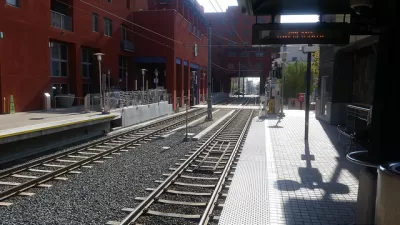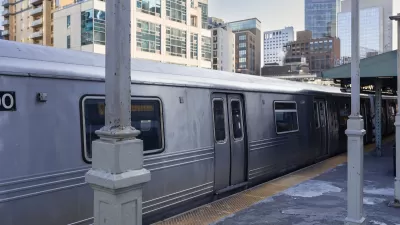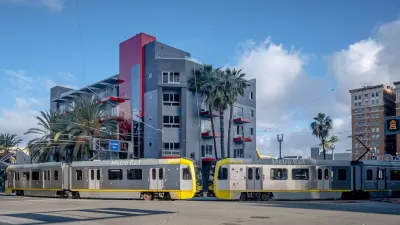Transit providers are often major landowners in their communities, controlling underutilized properties like park-and-ride lots or storage and maintenance facilities. These sites are also opportunities to provide desperately needed affordable housing

Public transit providers are struggling to make ends meet. Many agencies are in a vicious cycle: the increased use of ride-hailing and bike-sharing services means fewer riders, creating a decline in revenue, which, along with the chronic lack of funding, results in further service cuts. It doesn’t help that in many communities, an affordable housing shortage has displaced lower-income riders who typically rely on transit.
Phil Washington of Los Angeles Metro once said, “I don’t want to build new tracks, I want to make sure people can live near our transit.” It is this same spirit that is behind affordable housing advocates finding new allies—in public transit agencies.
Los Angeles’ Metro transit agency is one several around the nation that has focused on transit-oriented development and either partnered with affordable housing developers or promoted affordable housing near its stations. Since 2016, Metro has distributed $9 million in low-interest rate loans for affordable housing on land adjacent to its stations as part of its Joint Development Program. Like other agencies, Metro also has an explicit affordable housing policy, requiring that at least 35 percent of all housing units developed on its properties be set aside for households making less than 60 percent of the area median income, or roughly $56,000 per year. The program has generated more than 700 subsidized affordable units near the agency’s rapidly expanding system, with another 162 affordable units in construction, and almost 600 more in negotiation.
It turns out that transit agencies have a lot to gain from affordable housing. Transit providers are often major landowners in their communities, controlling underutilized properties like park-and-ride lots or leftover pieces of land from the construction of a new project, or storage and maintenance facilities. These sites are also opportunities to provide desperately needed affordable housing, which in turn creates increased ridership from residents and visitors, as well as additional revenue. For instance . . .
FULL STORY: Affordable Housing on Transit Land

Planetizen Federal Action Tracker
A weekly monitor of how Trump’s orders and actions are impacting planners and planning in America.

Congressman Proposes Bill to Rename DC Metro “Trump Train”
The Make Autorail Great Again Act would withhold federal funding to the system until the Washington Metropolitan Area Transit Authority (WMATA), rebrands as the Washington Metropolitan Authority for Greater Access (WMAGA).

The Simple Legislative Tool Transforming Vacant Downtowns
In California, Michigan and Georgia, an easy win is bringing dollars — and delight — back to city centers.

The Small South Asian Republic Going all in on EVs
Thanks to one simple policy change less than five years ago, 65% of new cars in this Himalayan country are now electric.

DC Backpedals on Bike Lane Protection, Swaps Barriers for Paint
Citing aesthetic concerns, the city is removing the concrete barriers and flexposts that once separated Arizona Avenue cyclists from motor vehicles.

In These Cities, Most New Housing is Under 441 Square Feet
With loosened restrictions on “micro-housing,” tiny units now make up as much as 66% of newly constructed housing.
Urban Design for Planners 1: Software Tools
This six-course series explores essential urban design concepts using open source software and equips planners with the tools they need to participate fully in the urban design process.
Planning for Universal Design
Learn the tools for implementing Universal Design in planning regulations.
Smith Gee Studio
City of Charlotte
City of Camden Redevelopment Agency
City of Astoria
Transportation Research & Education Center (TREC) at Portland State University
US High Speed Rail Association
City of Camden Redevelopment Agency
Municipality of Princeton (NJ)





























